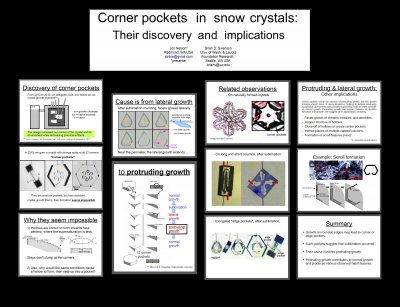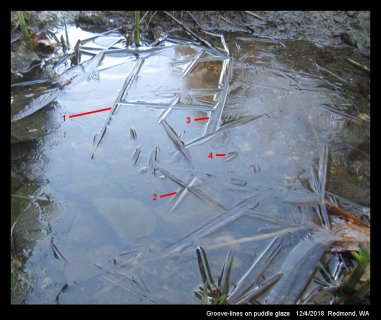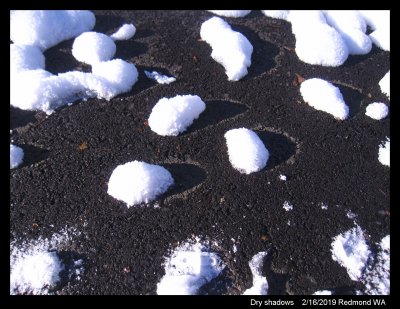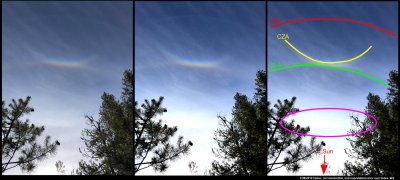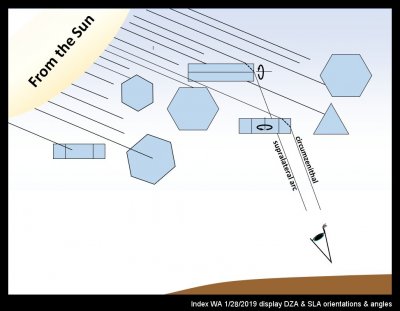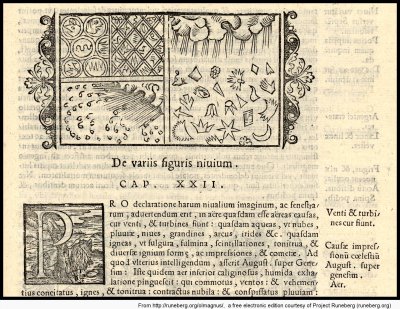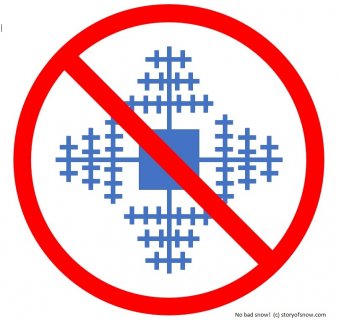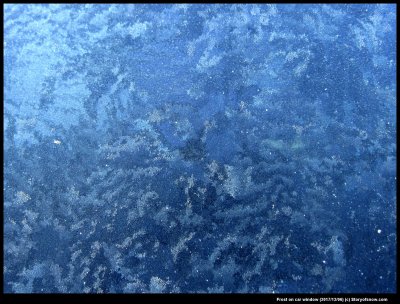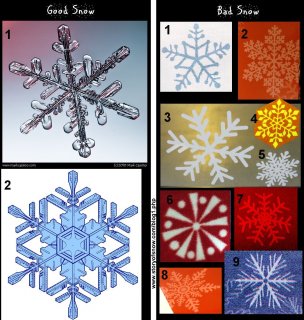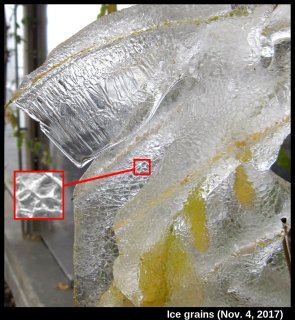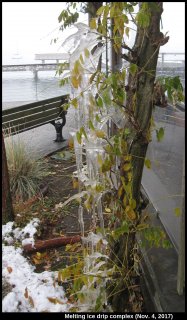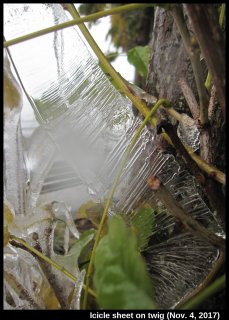Poster on corner pockets in snow crystals
February 18th, 2019Last July, I attended the AMS (American Meteorological Society) 15th Conference on Cloud Physics, which was combined with a similar conference on atmospheric radiation. They have these about every four years, but I have missed all those going back to 1995. So, I had a lot to catch up on. Actually, by far the most enjoyable part of this conference was meeting old colleagues and making new acquaintances, including many who I had known only through their papers and email correspondence. As to why I waited so long, I suppose the main reasons were time and cost. Even without travel and lodging expenses, conferences are expensive. This one was $600, and the fee for the abstract I submitted was an additional $95. But in this case, the conference was only a 3-hr drive away (Vancouver, BC) and my co-worker very nicely picked up the conference fee and hotel tab. Also, this conference had a special session dedicated to the work of my former advisor, Prof. Marcia Baker. In that session, I presented the following poster.
I've described a little about corner pockets in a previous post, and showed a few of these panels before, but will briefly go over them here.
Puddle gets its grooves (upon freezing), part I
February 16th, 2019These grooves appear on the surface of frozen puddles.
Most grooves are straight lines, and most of these also appear to have relatively symmetric sides, such as those marked #s 1, 2, & 4 in the above image. But some, such as #3, have sides that are much wider. Grooves can intersect each other at a "T" intersection, such as #1 and #3, or they can cross, as a 4-way intersection as in #2. Some, such as #4 start and end on nothing apparent and intersect no other grooves.
Sometimes the sides show small steps or sub-grooves, particularly on the wider sides, such as on #3. On grooves that curve, such as in #1 and #2 in the image below, one side can have a fern or foliage type of texture.
Strange dry shadows
February 14th, 2019Sunshine on pavement seems straightforward enough. It warms the surface, driving evaporation (or sublimation), and dries things out. Conversely, we know that moisture tends to collect on surfaces that are either colder or closer to a water source. And the moisture tends to persist more if the region is more enclosed. Agreed? Now, does anything look strange about these shadows?
The shadows of these snow clumps appear to be dry pavement, the regions in the sun moist. As the sun moved across the sky, the shadows moved, and once dry pavement that was formerly in the shadow became moist as it came into the sun. The image below was taken three hours later.
A rare heliac arc? (plus six others)
February 5th, 2019The day starts sunny and bright, but later you note a slight muting of the surrounding landscape. It is still bright enough, but you feel less heat bearing down. Apparently, a thin veil of high clouds has slowly and silently appeared above.
When this happens, please take a few seconds to look up and see what these clouds are up to. Do they have their crystals lined up for one or more arcs, or are they oriented randomly, giving a halo with perhaps a sun dog or two? To the trained eye, the chances are high that such a veil will give rewards, even when no crystals are present. But the crystals give so much more, particularly when they line up in various ways.
Wandering, somewhat exhausted, on the hillside above Index, WA last Monday, I got this very sense of a muted landscape. So, I found a break in the trees, looked up, and instantly felt recharged. A colorful circumzenithal arc had appeared, which by itself is always a treat. But I was also awed by several other arcs and a very diffuse 22-degree halo. Excitedly, I took photos and scrambled around trees and rock for a more complete view.
(As with all images here, click on the image to see a larger view.)
Due to the complex way the eye and brain discerns light and patterns versus the much simpler way of a camera, the patterns are much more distinct when viewed direct by eye. But the above composition has my attempt to compensate the original photo at left, with some contrast enhancement in the middle version, and markings on the right version.
The band of color at the intersection of CZA and SLA is from the oriented prism crystals of the circumzenithal arc (CZA). Their formation is relatively common I think, though a group of observers in Germany apparently finds their occurrence there to be only about 13 times per year (https://www.atoptics.co.uk/halo/whyinfr.htm). What is most remarkable to me is not their colors, but the fact that formation of distinct colors requires that the crystals stay extremely level as they fall (deviations of only a few degrees would wash out the colors). My sketch below shows roughly what is going on here:
(Hold on for a moment, and I'll get to the rare heliac arc below.)
Bad Snow, Part II, and Some History
December 11th, 2017The recent post about bad snow (see new emblem at bottom) reminded me of an old image that often pops up in historical descriptions about snow. The date was 1555 and Olaus Magnus, an archbishop in Sweden, just published "Description of the Northern Peoples", a long multi-chapter, multi-volume text with the interesting chapter for us being titled "The Shapes of Snow" with the following illustration.
I am not sure what the sections on the left half represent, but the right half shows a fanciful variety of "snow shapes", including a bell, a hand, an arrow, a crescent moon, and one at least in the form of a six-pointed star. Perhaps the author gave incomplete instructions to his illustrator.
At any rate, scholars have suggested that this illustration is actually the first to show the form of snow. Though the Chinese had many centuries before correctly described snow's "six-fold" nature, no illustration has yet been unearthed before Olaus Magnus's above. Luckily, it wasn't so many centuries later that we got much more accurate illustrations from the likes of Descartes and Hooke.
Finally, as promised, the proposed "No bad snow" emblem.
--JN
Film frost grains and radiative cooling of the ground
December 10th, 2017December 8th brought the first frost to the Seattle area. This doesn't mean that this is the first time this season that the ground reached 0 degrees C or lower. True, we had gotten snow in late November, though this by itself doesn't mean the ground reached 0 C because snow deposition differs from frost formation. The snow was below zero when it formed in the air, but for the rest of its existence, it could have been melting and the ground itself likely sped up the process by remaining slightly above 0 C. But in contrast with the snow, for frost to form, the ground itself must cool below 0 C.
When I used to put out some metal plates with recording thermocouples, I didn't see visible frost until about -5 C, but that was based on just a handful of measurements. Anyway, what this means is that we may have had a few mornings with some patches of ground (including anything connected to the ground) dipping slightly below zero but with no obvious frost appearing. Also keep in mind that "ground temperatures" reported at weather stations are 1.5-2.0 meters above the ground, and thus may be 5-10 degrees C warmer at night than some ground patches. Why? At night, the ground cools by radiating, and if the atmosphere is not radiating much down, then considerable cooling happens. This is why clear nights are the ones with the most frost or dew.
Anyway, here is one shot of some of this "first frost" on my car window.
The image shows patches of different texture. These regions differ in texture because they are tiny hoar-frost (i.e., vapor-grown) crystals of differing size or orientation. That is, they stick up differently in different patches. They stick up differently because they sprouted off of a thin layer of film-frost that had a different crystal orientation. So, the patchy look comes from the different grains in the film-frost. See some of my previous posts with diagrams about this phenomena (category: "film frost"). Here is one with particularly helpful diagrams.
http://www.storyofsnow.com/blog1.php/choppy-waves
-- JN
Bad Snow
November 28th, 2017This post is about the misrepresenting of snow crystals in public, not about misbehaving crystals and not about snow that has gotten dirty.
No doubt you've seen it, the Christmas card with four-pointed "snow" falling, or the sweater with an eight-pointed "snow" emblem. Once, at a holiday party, I saw such a sweater and remarked on it to the wearer. I was told that, with snow, "no two are alike", and apparently that was supposed to justify anything goes. Sorry, but it doesn't work that way. After all, we can say the same thing about people, that is, no two of us are exactly alike, and yet we do not regularly see sketches of people with five arms or three heads. That is because people do not come in these shapes. Similarly, snow-crystal growth allows unlimited crystal forms, but nevertheless follows strict rules. If you understand these rules, you too can point out impossible snow-crystal shapes. I give the rules below.
But to help illustrate these rules, I first present below examples of real and "good" snow, together with some examples of bad snow:
Click on this (and any image here) to see a larger version.
That Snow Joke
November 17th, 2017A variation on a joke I heard from the UK Laugh Lab, customized for you snow-blog readers:
--------------
Sherlock Holmes and Dr Watson go snow camping. After a day snowshoeing around the forest, they return to their camp, have some wine, and crawl into their sleeping bags.
Some snow flurries drift down.
Sherlock says to his friend "Watson, the snow is falling on us, what does that tell you."
Watson gazes up at the drifting flakes, thinks for a moment, then replies:
"Well, first off, I'd say that the forecast was wrong, but snow is notoriously difficult to predict so I won't disparage the meteorologist. About this particular snow, it appears to be nicely branched dendrites, so I'd deduce then that they formed near negative fifteen degrees, surrounded by small droplets. Furthermore, I'd...Er, what are you doing?"
Sherlock was out of his bag, looking around the camp.
"Watson, Someone has stolen our tent!"
--------------
- JN
Grain boundaries between crystals in big ice
November 6th, 2017Most snow crystals are single crystals. Being single is an outcome of their growth process and small size. On the other hand, most larger ice formations are not single crystals. These latter types are called "polycrystals". A polycrystal usually appears the same as any other type of ice -- smooth, uniform, clear or white -- just as if it were also single crystal. But the poly nature can be revealed when the ice warms to the melting temperature. At melting temperature, the boundaries between the separate crystals become visible. As an example, note the white lines in the ice in the inset in the image below.
(This image is from the ice drip complex in the previous post.) We call each individual crystal a "grain", and the boundaries between grains as "grain boundaries". The grain boundaries show up because the region has disordered ice that will melt at a lower temperature than regular ice. Thus, the light, upon passing through a grain boundary, will scatter more, making a whiter region, as shown in the image.
The ice is thus weaker on a grain boundary and has a tendency to break along these boundaries. On the surface of ponds and lakes, the grains (individual crystals) can be several inches or more across. So, if you get a sheet of such ice, and let it warm up to melting, you will find it easy to break the ice sheet along a grain boundary and thus isolate a large single crystal.
The size and pattern of the grains affect the mechanical properties of the ice. So, glaciologists, who want to know how a given glacier or ice sheet moves, are very interested in such patterns. They call this pattern the "ice fabric".
-JN
Sheet icicles
November 6th, 2017On a bitter cold day in 2013, I was at a familiar cliff, climbing under a large rock ceiling. A little water had been seeping down through the crack above, forming an ice-filled crack that I had to dig out with my hammer to proceed. In a few spots, the water drips had detoured, meandering along the granite ceiling and freezing into very thin s-curved ribbons of ice. I'd never seen any drip formation so bizarre, or even seen a picture of anything like them. But my camera was far below, and I had to regretfully blast through the ice to proceed.
Recently I came across another thin, sheet-like ice formation on a small tree under a drip. In this case, the sheets followed a twig, and thus did not meander in s-curves. But they were similarly thin and sheet-like. Call them "sheet icicles". This time I had my camera handy.
Here's an overview of the drip formation.
And a close-up of one of the sheet icicles.
